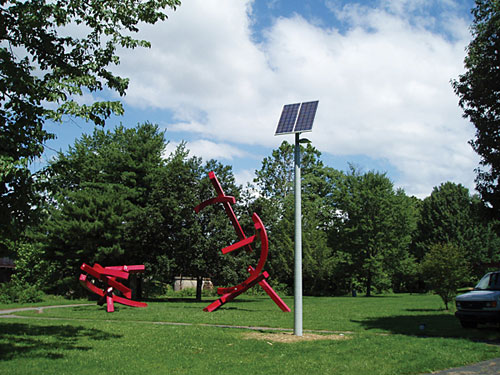Solar Lighting: Making Steps Off-Grid towards a Sustainable Future
Components Used in Off-Grid Solar-Powered Luminaires
All off-grid solar-powered lighting systems use five basic parts including a charge controller, battery, panel, luminaire and balance of system (BOS). Miscellaneous parts such as wiring, pole, enclosure, mounting, etc. are all included in the BOS.
Charge controller. The charge controller is a critical component of an off grid solar lighting system. Some of the key tasks of a charge controller are to regulate battery charge from the PV modules, maintain the batteries at their highest state of charge and prevent overcharging or over discharging. All of these features help to maximize the battery performance and life. Charge controllers with load control also manage energy flow between modules, batteries and the load. In this case, the load is the luminaire which can be programmed to operate on a specific time schedule (e.g., a luminaire may turn on for 8 hours after sunset, turn off for 4 hours and then turn on again until sunrise). The latest innovations in charge controller technology are Maximum Power Point Tracking (MPPT) and Pulse Width Modulation (PWM). Voltage and current produced by a PV module change independently depending on temperature and irradiance conditions. Irradiance refers to the intensity of available solar resource. MPPT controllers use electronics to increase the total watts produced by taking advantage of the maximum voltage and current values generated by the module during actual operating conditions. Colder climates tend to see the largest boost in performance by this technology with efficiency increases up to 30 percent. PWM is a technology that can be used for battery charging or switching LED-based lighting. The technology switches a series device on and off at a high frequency and for variable lengths of time. PWM charging can maintain a higher battery state of charge and increase the life of the battery. A PWM output can cycle LEDs on and off at such high frequencies that no visual change is noticed while energy consumption is reduced.
Batteries. Valve Regulated Lead Acid (VRLA) deep-cycle batteries are the most common battery technology used in PV systems. Gel and Absorbed Glass Matt (AGM) are both VRLA batteries commonly used for their many advantages. These batteries have the ability to handle deep discharge cycles and have low self discharge rates. They are also fast to recharge, require no maintenance and have low to no off gassing. Being of the non-spill and low off-gassing type allows Gel and AGM batteries to be transported by air; a big advantage for distribution. Operating temperature of a battery affects the internal resistance and its ability to hold a charge. A multiplier can be applied to batteries operating at temperatures below 80 °F to determine reduced capacity. The capacity of a battery is measured in Amp-hours (Ah) and is typically specified at a 20-hour rate. This means a battery with a 100Ah capacity will operate at a discharge rate of 5 Amps for 20 hours. (5A x 20h = 100Ah). If the battery is operated at a higher discharge rate, it will produce less than the rated capacity. For example, a 100Ah battery operated at a 10-hour rate (10A) will produce approximately 60Ah of capacity. Warranties offered for some VRLA Gel and AGM batteries can range up to five years, but years can be added to the overall life when operating conditions are favorable.
Panels. PV modules typically utilize one of three main cell technologies, mono-crystalline, poly-crystalline and ribbon silicon. These cell types convert solar radiation to electricity with an efficiency of approximately 11 percent to 18 percent. Efficiency and cost tend to go up together and forces other factors such as available area and application of the module to determine which technology should be used. Mono-crystalline modules offer the highest efficiency at 14 percent to 18 percent but also have the highest manufacturing cost. Poly-crystalline modules are 11.5 percent to 14 percent efficient and they tend to have the best balance of cost, efficiency and size. Ribbon silicon otherwise known as amorphous thin film has the lowest efficiency at 11 percent to 13 percent and requires a larger area to produce the same amount of power versus mono-crystalline and poly-crystalline. Amorphous thin film does however have some unique performance advantages making it desirable for specific applications such as when primarily diffuse sun light is available. Utilizing diffuse sunlight better allows this cell technology to tolerate shading and produce more power from early morning and late day sunlight. New technologies such as bi-facial cells and total internal reflection modules are being developed but have not been studied in practice long enough to break into the mainstream.
Luminaire. In order to make the most of the power generated by the power source an efficient and effective luminaire must be used. A luminaire is a light fixture complete with a lamp, voltage regulator (electronic ballast), luminous opening with or without a lens and a connection to a power source.
 |
Solar lighting as an architectural form Photo: SELUX Corp. |









